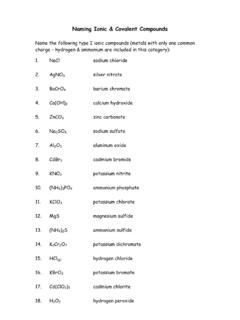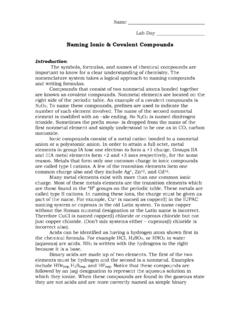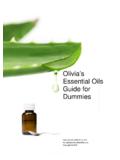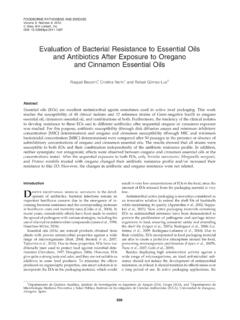Transcription of Lab 3 Steam Distillation - Chemeketa Community College
1 1 CH242 Lab 3: Steam Distillation (W15) Lab 3 Steam Distillation Isolation of essential oils Purpose: Isolation of essential oils from plant sources by Steam Distillation Techniques Steam Distillation (Mohrig, Steam Distillation ) Extraction and Washing (Mohrig,) Discussion: essential oils are the more volatile substances found in the roots, bark, leaves, flowers, fruit or seeds of plants. These compounds have uses ranging from medicines and aromatherapy to flavoring agents and perfumes. Some examples are quinine from the bark of the cinchona tree, vanillin from vanilla pods, and rose oil from rose petals.
2 The interest in essential oils has increased as people are looking for natural oils to use for relaxation and self-therapy and, in some cases, as a substitute for traditional western medicine. In this experiment we will provide several common cooking spices as the source of essential oils . If you have a preferred spice or other material (flowers, roots, bark, etc.), you may provide your own. essential oils , while volatile, have boiling points well above the boiling point of water. In many cases, distilling an essential oil at its boiling point results in the degradation of the desired product as it will oxidize at these high temperatures.
3 Steam Distillation is a technique that co-distills the essential oil with water at a temperature slightly lower than the boiling point of water. This process is an application of Dalton s Law of Partial Pressures. This law tells us that the total pressure (PT) of the system is equal to the sum of the partial pressures. In our case the total pressure is equal to the vapor pressure of the water (PH2O) added to the vapor pressure of the essential oil (Poil). PT = PH2O + Poil (1) While each essential oil has a unique vapor pressure, each will contribute a few percent to the total vapor pressure.
4 When the total vapor pressure above the solution is equal to atmospheric pressure (Patm) the solution will boil. Patm = PT (2) The result is that the mother liquor will boil at a temperature near but below the boiling point of water. Steam Distillation then has two significant differences when compared to a simple Distillation . By Steam distilling the essential oil, the oil is collected at a temperature well below its own boiling point. This significantly reduces the likelihood that the essential oil will be oxidized during the Distillation process.
5 The second difference is that the essential oil will be collected with water. Since the essential oil is not soluble in water, it will form as a separate layer (by density) from the water and can then be relatively easily separated from the water. Greening the Chemistry This laboratory experiment demonstrates three key green principles: design for degradation, the use of renewable feedstocks, and safer solvents and auxiliaries. In this experiment the green principles of design for degradation and the use of renewable feedstocks are not changes to the traditional isolation of essential oils .
6 essential oils have always been isolated from natural products and both the feedstocks and essential oils generally degrade easily in the environment. This is not to say that concentrated essential oils are not hazardous to human health or the environment. Many natural products have hazardous properties and should be evaluated on a case-by-case basis. All starting materials waste can be disposed of non-hazardous waste. The hazardousness of the essential oil product should be evaluated once the essential oil is identified and then disposed of appropriately.
7 For a proper evaluation of how renewable the feedstock is, one needs to know how it is being grown and harvested. Is it a native plant that can be found easily or is it farmed? If it is farmed, is it grown in a sustainable manner? Is it harvested in a sustainable manner? Rarely are the answers to these questions as simple as the questions themselves. Traditionally essential oils have been Steam distilled and then separated from the water using methylene chloride (CH2Cl2). essential oils are immiscible with water and so the solvent is not required to extract the essential oils from the water, but instead is used to aid the separation usually in a separatory funnel.
8 As we explore this experiment we will consider other alternatives including safer solvents and mechanical separation. The procedure given below is a compilation of common essential oil isolation procedures that have been used traditionally in the organic laboratory. As part of your pre-laboratory preparation for this experiment you will consider alternative procedures for the extraction of essential oils . 3 CH242 Lab 3: Steam Distillation (W15) PPRROOCCEEDDUURREESS:: ACTIONS: I. TRADITIONAL Steam Distillation : 1.
9 Prepare and mass 5 grams of dried material1 or between 10 and 20 grams of fresh plant material for Steam Distillation by separating the material to be analyzed (flowers, leaves, seeds, etc.) from the rest of the sample. 2. Grind the material using a mortar and 3. Transfer the material to a 250 or 500 mL round bottom flask (RBF)3 and add enough water to the RBF so that it is about 1/3 rd full.. 4. Setup an internal Steam distillation4 and distill. Collect the first 10 mL separately as this fraction often has most of the essential oil from the sample.
10 Continue collecting until you have collected about 30 mL of distillate. 4 5. Consider your product. If it is formed into a single drop, collect it using a pipette. If you have multiple droplets, transfer the product and water to a centrifuge tube and spin it down. A single droplet should form. Collect the product using a pipette as above. If no product is visible, but the sample has a distinct smell, extract the sample using one 5 mL washing of CH2Cl2. 6. Collect the CH2Cl2 layer in a small sample container and let it sit open in your drawer for one week to evaporate off the CH2Cl2.













